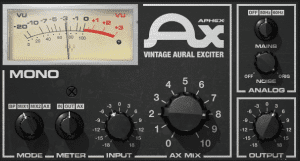What is an Exciter? (and How to Use It During Mastering)

One of the less known effects producers sometimes use is an exciter. Either as a plugin or a piece of hardware, an exciter is made to do one thing: add excitement to your mix and master.
We thought it’d be good to go over what exactly an exciter does so that you can know when best to use one in your mixing and mastering process.
What Does an Exciter Do?
Some would classify an exciter as a type of distortion effect. However, it’s really more than that. An exciter adds saturation to the signal frequencies in the higher ranges (3k and up). This produces more overtones and adds richness and crispness to your mix. It enhances the sound where EQ alone can’t seem to get it.
The effect was originally discovered by accident, when the pro audio company Aphex found that playing a track simultaneously with a thin, distorted signal of itself added clarity to the overall sound. Since then, a handful of similar effects–enhancers, vitalizers, etc–have come out, all adding brightness or fullness to your mix by applying an EQ and distortion combination. Dolby even incorporated the technology into its audio components to produce their exclusive enhanced sound.
You can recreate the effect of Aphex’s original exciter by adding some distortion linked to a high pass filter.
When To Use an Exciter
When using an exciter, it’s often best try it out on the stems of your mix rather than on the whole master bus, as it can work to reduce the depth of your sound if it’s overused. Most commonly, exciters or enhancers are used to bring one part towards the front by cutting through the mix. Often vocals, are the most popular application.
If you’re interested in using an exciter, we recommend looking into the Aphex Aural Exciter or the BBE Sonic Maximizer. They’re some of the most popular and longstanding exciter effects out there.
As with many effects, less is more. Too much of it and your mix will suffer. But, using an enhancer sparingly and in just the right parts will yield the best sounding, and most exciting, mix and master.




